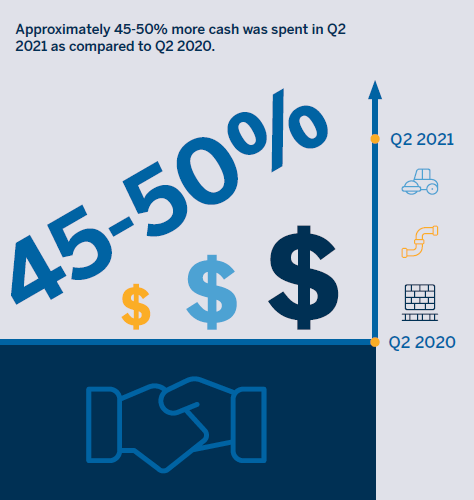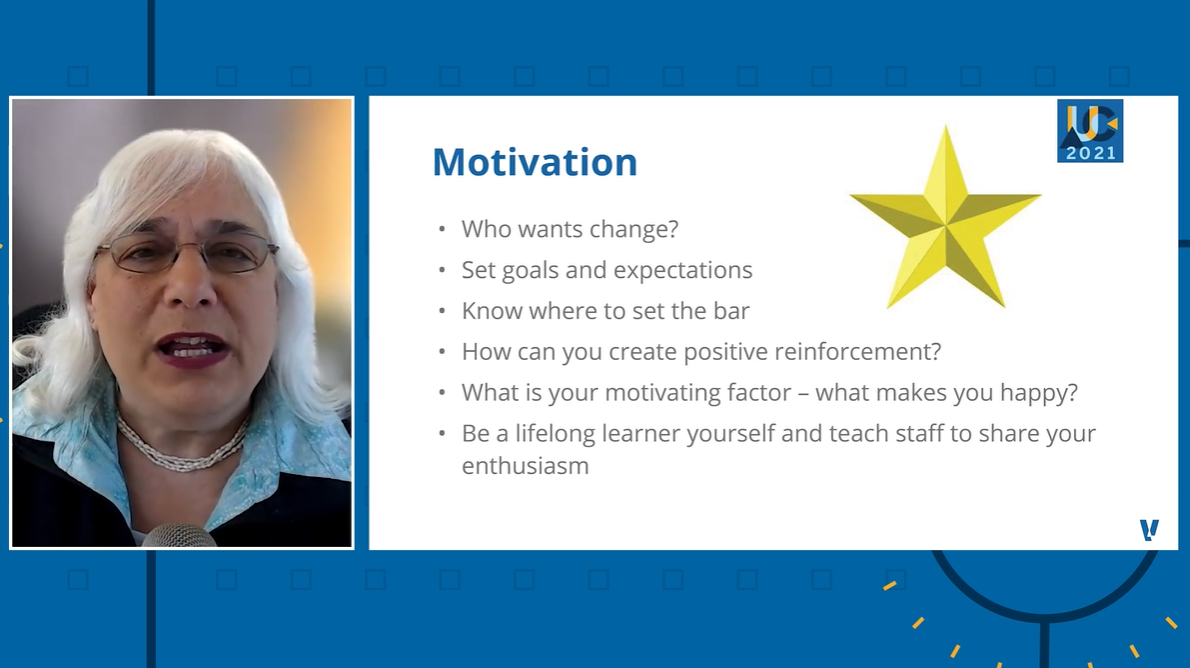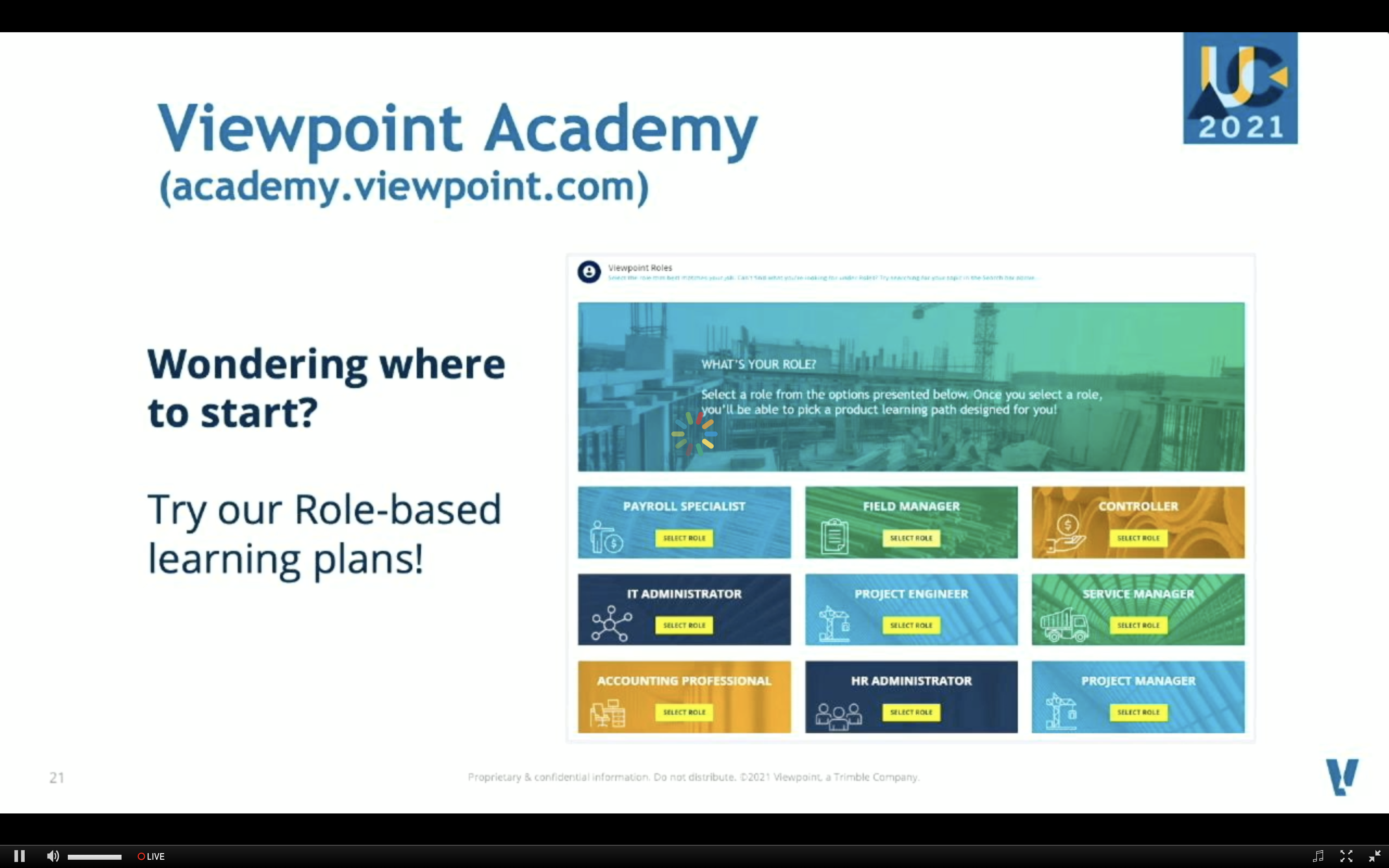13 Minute Read
September 14, 2021
0%

While day one of Collaborate was all about connected construction, the Trimble technologies fueling today’s data-driven contractors and the introduction of Trimble Construction One (which you can learn more about below), Collaborate day 2 was all about inspiration.
We heard some amazing new technologies now available and cool stories from Trimble Viewpoint’s customers on how they’re using them. We learned about construction best practices that inspired attendees with takeaways they can begin to immediately implement at their organizations. We learned about positive industry trends and technology innovations either available now or coming shortly for contractors to run better businesses. And we found new inspirations to better ourselves and achieve our personal goals from keynote speaker Laila Ali.

We’ll start our Collaborate day 2 highlights with Laila Ali, who delivered a powerful presentation, “Rise Above” during Collaborate’s day 2 keynote session.
Ali, daughter of legendary boxing champion Muhammed Ali is herself a boxing champion—undefeated no less, with 24 wins and 21 knockouts. However, she has consistently reinvented herself to become much more than a boxer. She’s a mother, wife, entrepreneur, television personality, chef, lifestyle coach and so much more.
She detailed her early years and independent streak where she wanted to make her own name for herself, opening a nail studio and spa at the age of 18. “I took my business very seriously and planned to open a chain of spas all around the country,” Ali said.
One night, she went to a friend’s house to watch a Mike Tyson fight and on the undercard were two women boxing. Ali had never known of female boxing as a sport before that and was glued to the television. One of the women boxing that night was Christy Martin, who helped put women’s boxing on the map. Ali said she realized then and there that she too wanted to be a professional boxer.

She began training around the clock, but did so largely in secret. Once the word eventually got out of her training, it prompted a conversation with her father. “He tried to talk me out of it, noting the pressures of the spotlight. But it didn’t go the way he wanted,” she said. “He finally said what was on his mind: ‘Laila, it’s not for you. It’s a man’s sport.’”
Determined, Laila pressed on. When she made her pro debut, there were 80 different media outlets watching. She won a first-round knockout. “It was the most exhilarating feeling. Tasting that knockout made me want more,” Ali said.
And more she did: defeating the daughter of another legendary boxer, Joe Frazier, in the ring; winning her first championship title; successfully defending that title; and a fight with one of her inspirations—Christy Martin—who she defeated by knockout in the fourth round.
After proving herself, she had another conversation with her father. “He said, ‘I’m sorry. I was wrong, you were right. You can fight. Women can fight.’”

Laila Ali retired from boxing on her own terms, her last fight taking place in South Africa with Nelson Mandela in attendance. “It was such a big event. He was a true boxing fan and had an amateur career of his own. I won in a first-round knockout,” she said.
After boxing, it took her some time to find new inspirations. During that time, she got a call from the television show “Dancing with the Stars.” Ali didn’t want to do it at first, but reconsidered. She wanted to challenge herself and show another side of her personality to wider audiences.
“I went all the way to the finals and did exactly what I wanted to do—get my name out there to 40 million people,” she said.
That led to many other opportunities. Among them: hosting television shows; writing her own cookbook for healthy eating; creating her own brands of spice blends; and starting her own website: Laila Ali Lifestyle.
Today, she’s happily married to former NFL player Curtis Conway with two children. Her family is at the core of everything she does. “Now I’m focusing on my brand and sharing my stories with others,” she said. “There is always going to be change in our lives and today it's more important than ever to be as efficient as possible to get our work done and still do the things we want to do...it’s about doing the things you love.”
Anne Hunt, director of data and analytics for Trimble Viewpoint presented the latest industry metrics and trends from our Q2 2021 Construction Metrics Index report. The index analyzes data from roughly 1,000 Trimble Viewpoint customers, looking at project stats, contract values, hiring metrics and cash flow trends.
2021 is proving to be a year of recovery as contractors continue to try to get their businesses back on track. Here are some highlights:

Contract values trends:
Hiring trends:

Cash flow:

Cybersecurity Factors Must Remain Top-of-Mind for Contractors:
Cybersecurity consultant Bryce Austin of TCE Strategy kicked off “Cybersecurity: How to Not be a Target” with a personal story about his own experience working as an employee during Target’s major 2013 breach—a big headline in a time before breaches were as common as they are today.
“Target didn't understand the risk [surrounding data breaches],” Austin said. “The executives at Target hadn't lived through a major cybersecurity incident and they weren't making headlines every week of the month the way that they are now in 2021. This was new and that risk wasn't understood by many, many companies.”
Austin went on to detail many other headline incidents—from Sony’s breach after announcing the release of the movie “The Interview” to the recent Colonial Pipeline hack—as well as provide practical advice to those who want to protect their data (and why they must protect their data). First and foremost, Austin said, was knowing where to focus: The common methodology to every breach was a chain of events in which each step is necessary for the hacker to succeed:
Phishing
Hopping
Scraping
Aggregating
Exfiltrating
Disrupt any of those steps and companies can stop the breach. Or, as Austin says it: “Stop any step, stop any breach. All of these things have to happen in order for a breach to take place. And if you can detect and disrupt any one of these five, you will stop the breach. That’s an important take-home message.”
In a future blog, we’ll cover some of Austin’s s “Actionable Steps” that you can take to ensure you’re covering your bases in protecting your data. In the meantime, check out our blog: Why It’s Critical to Have a Sound Cybersecurity Strategy.

Helping Project Managers Understand the ‘Financial Stuff’
When it comes to profit, employee cost metrics—job costing your labor and tracking your employee utilization—are often at the forefront of those discussions, says Leslie Shiner, owner of the Shiner Group, who also held a session for construction project managers on cash flow forecasting (detailed below).Shiner detailed two areas: Understanding labor costs (often at an intimate level) and talking through the three ways to increase profits.
“How many of you want to make 10% more money?” Shiner proposed to the audience. “I often ask that, and everybody's going to raise their hand. Now how many of you want to make 10% more money by actually working 10% more hours and 10% harder? Well, not as many people want to do that.”
Instead, the “Profit Cycle” Shiner refers to starts off with the right estimates, because budgeting provides the basis for proposals and invoicing. The key metric to look for is gross margin, which allows project managers to compare different jobs of different sizes and understand which are offering the greatest profit to the organization. In the end, there are three ways to obtain that gross margin:
Charge more
Spend less
Sell more
So which is the best method? Turns out, it’s a combination.
“I've seen way too many construction companies increase their volume and lose their shirts,” Shiner said. “Double the volume, lose your shirt, because all of a sudden you're selling more. Now, you're managing six more jobs than you managed last month, now you don't have time to finish those jobs and you have to leave and go do something else ... they all of a sudden go from being on time and on budget to not on time and way over budget. So selling more is not the easiest way to improve profits, spending less and charging more is the way to go.”

Project Manager’s Guide to Cash-Flow Forecasting:
In the big picture, cash flow is more than just income and expenses, Shiner said. It’s all the money you take in and all the money you put out. It might sound oversimplified, but taken more broadly, money-in can also be borrowing funds, selling assets, or obtaining an investment from outside sources. It could be incentives, grants, or tax credits—especially now with the Employment Retention Tax Credit and PPP loans there are a lot of ways to get money, and it’s more than just income.
Likewise, money-out isn’t just the cost of goods sold, or operating and overhead costs; you’ll also have to have liquid cash to pay loans or purchase assets, or loans on equipment, for example. Then there’s the dreaded “T”-word (taxes).
With all of these factors at play, Shiner gives more plain-spoken advice for ensuring your cash flow is there when you need it: “Make sure you use your discounts. Use credit cards carefully, but to your advantage. Look at ways to borrow money and look at ways to improve your cash-flow and profits using the four tools” referenced in the webinar:
Be on the lookout: We’ll take a closer look at cash flow forecasting in greater detail in an upcoming blog.

The Importance of Training:
Shiner also spoke on the importance of building training programs into your business model to achieve stronger results and meet goals. Effective training programs, she said, increase productivity, reduce slippage on goals, lead to happier, more engaged employees and significantly reduced business costs. Companies that spend on training can actually save an average of $4,500 per employee in costs elsewhere, Shiner said.
“Think of training as an investment, rather than a cost,” Shiner said. “If you can create a company where training, success, teamwork and culture are valued you should be able to create a company that keeps your employees.”
Shiner provided a number of tips on the types of training platforms and channels that are most effective, and the following tips on what to think about when creating training programs:

Vista and Spectrum users got an up-close look at a few of the technology advancements they can start using now (and features in the works) as part of the Trimble Construction One platform.
Trimble Viewpoint’s Betsie Hoyt, director of product management, walked attendees through a review of how Trimble Construction One is providing a more connected construction experience to Plan, Do and Manage, including a breakdown of how each role in the construction organization benefits.
“Everyone in the construction business has responsibilities for the people, projects, processes that they interact with as part of their role—and they have to collaborate across roles, departments, and even outside partners in order to function,” Hoyt said. “This is clearly made more complicated as many roles and organizations have to work together—often across many barriers.”
Helping these contractors plan better, estimating, detailing and modeling data and workflows are now directly connected to the back office Vista or Spectrum ERP solutions through Trimble Construction One. Connecting estimates to supply chains and accurate costing helps contractors achieve more precise estimates, better benchmark against past performances or other industry benchmarks, lead to increased resource utilization and productivity and identify areas of opportunity for pre-fabrication or workflow automation.

Now, Trimble Construction One Vista or Spectrum users have direct connections to Trimble MEP bundles for estimating:
“The estimator creates the estimate in Accubid or Autobid and set up the cost codes as necessary for the project. The estimate is then exported into a portable template,” said Karl Rajotte, director of enterprise systems integration at Trimble Viewpoint. “Then, the template is taken and uploaded into the Trimble Construction One ERP to set up their budget. The template enables you to import all of the material and labor—broken down by cost code. This is huge, because otherwise the entry of this information would have to be done manually.”
Additionally, Trimble Construction One users can also access data and workflows Trimble MEP’s VDC Pro+ solution for design and detailing.
Connecting these solutions and data will provide seamless workflows between the planning stages and the manage stages
“Estimates and budgets set up with one source of truth—right in your ERP,” Hoyt said.

Helping connect “managing” and “doing,” new workflows interconnect budget and cost management so that data flows seamlessly between the Vista or Spectrum ERP and the project management solution.
Dan Conway, Trimble Viewpoint’s senior director of product strategy and management, showed how Vista and Spectrum users can access project financials directly through the Viewpoint Team project management solution.
“We recently also introduced another solution to our portfolio called Project Site, which will also allow project managers and field personnel to have access to project information,” Conway said.
Though Spectrum connections to Project Site are in the works, Vista and Project Site are currently connected across five key integration points:
These five connection points allow Vista users to work in their ERP as they always do while the data automatically flows into Project Site, where the project manager or field team leaders can use that data to better inform and manage their projects.
Integrations between Vista/Spectrum and Tekla’s PowerFab suite of pre-fabrication management solutions were also highlighted. A video of Dave Steel Company’s Babette Freund gave a real-world example of how these integrations worked, which you can watch here:

For Trimble Viewpoint, the measures of our technology success are made on how successful our clients are. That’s why we partner directly with customers, giving them a bevy of resources and tools to improve their technology experiences and maximize their technology investments.
In a special session devoted to customer success, we broke down some of these resources:

Through the Viewpoint Customer Portal, you can quickly access a vast array of resources we provide as part of your subscription, including the Viewpoint Network, Viewpoint Academy, and Viewpoint Help. You can also connect with our Professional Services team. Through the customer portal, you can:

The Viewpoint Academy provides ongoing customer training and education opportunities. We want to make sure you have the tools you need to be successful and get your software up and running. The Academy provides:

Trimble Viewpoint’s Professional Services helps clients maximise their technology usage and investments, by providing experienced consultants with deep expertise in construction issues and our products and services. The Professional Services team helps by:

Trimble Viewpoint Help is there when clients need it, with teams of dedicated and experienced support professionals ready to address technology issues they might run into. Our support teams:

The Viewpoint Network is Trimble Viewpoint’s online community that connects clients with other users, Trimble Viewpoint professionals and others through robust discussion forums, engaging activities, learning opportunities and more. Exclusive to customers and partners, The Viewpoint Network:
13 Minute Read
September 14, 2021
2 Minute Read
July 27, 2021